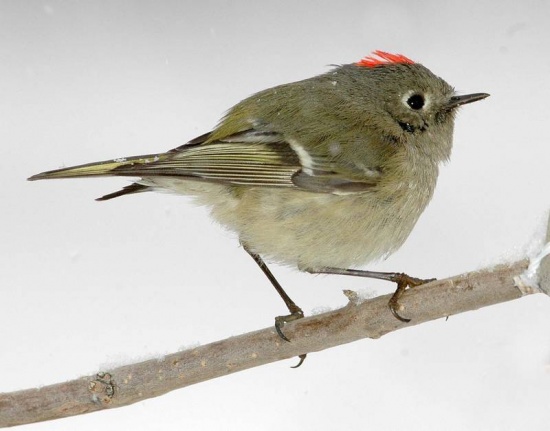| Line 1: | Line 1: | ||
| − | [[Image:Ruby-crowned_Kinglet.jpg|thumb|550px|right|Photo by fugl Location: Reno, [[Nevada]], [[ | + | [[Image:Ruby-crowned_Kinglet.jpg|thumb|550px|right|Photo by fugl Location: Reno, [[Nevada]], [[USA]]]] |
;[[:Category:Regulus|Regulus]] calendula | ;[[:Category:Regulus|Regulus]] calendula | ||
Revision as of 17:23, 31 December 2009
- Regulus calendula
Identification
9-11cm. Thin bill, broken eye ring, olive upperparts, pale olive underparts, white wing bars, yellow edges to flight feathers and tail. Male has red patch in centre of crown (not always visible).
Distribution
Most of North America
- resident in most of Utah and Nevada, as well as Southern Idaho and Northern Arizona
- winters in the southern half of the United States and Mexico
- summers in New England, Canada, and Alaska, as well as parts of Idaho, Wyoming, Colorado, and Montana
- can be seen throughout the rest of the United States when migrating
Taxonomy
Three subspecies are recognized:[1]
- R. c. grinnelli - Coastal North America
- R. c. calendula - North and east Canada to northeastern US; winters to Guatemala, Cuba, Bahamas
- R. c. obscurus - Guadalupe Island, Mexico.
Habitat
Comon and widespread in coniferous and mixed forests, as well as riparian areas. Highly migratory.
Behaviour
Often travels in small mixed flocks. Forages busily (almost frantically) along branches of trees and bushes. Often in dense brush or thickets. Extremely active, rarely perching for more than a few seconds. Only raises the brilliant ruby crest when excited.
- Diet: The diet includes insects such as moths, beetles, ants, wasps, butterflies, caterpillars, spiders and elderberries and weed seeds. They also drink tree sap and some fruit.
- Breeding: Both sexes build the nest which is a hanging globe shaped cup among twigs of a pine branch. The nest is built of moss and cobwebs and lined with feathers, rootlets and soft bark. The nest can be found in a spruce, firs or pines. 5-11 (usually 7-9) eggs are laid which are white with brown spots. The eggs hatch within 12-13 days and are incubated by the female. The first young leaves the nest approximately 13 days after hatching.
References
- Clements, JF. 2008. The Clements Checklist of Birds of the World. 6th ed., with updates to December 2008. Ithaca: Cornell Univ. Press. ISBN 978-0801445019.
Recommended Citation
- BirdForum Opus contributors. (2024) Ruby-crowned Kinglet. In: BirdForum, the forum for wild birds and birding. Retrieved 12 May 2024 from https://www.birdforum.net/opus/Ruby-crowned_Kinglet




